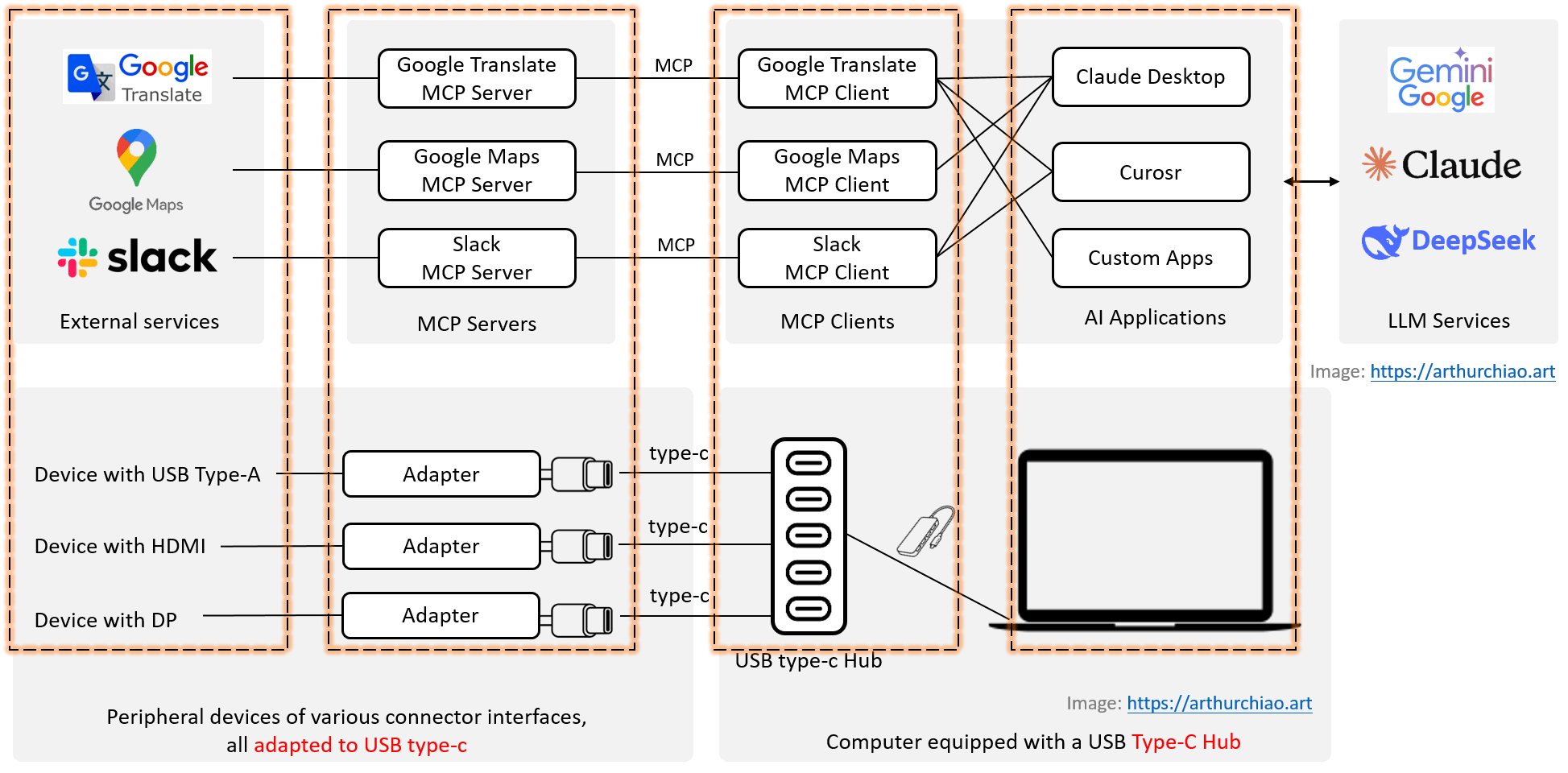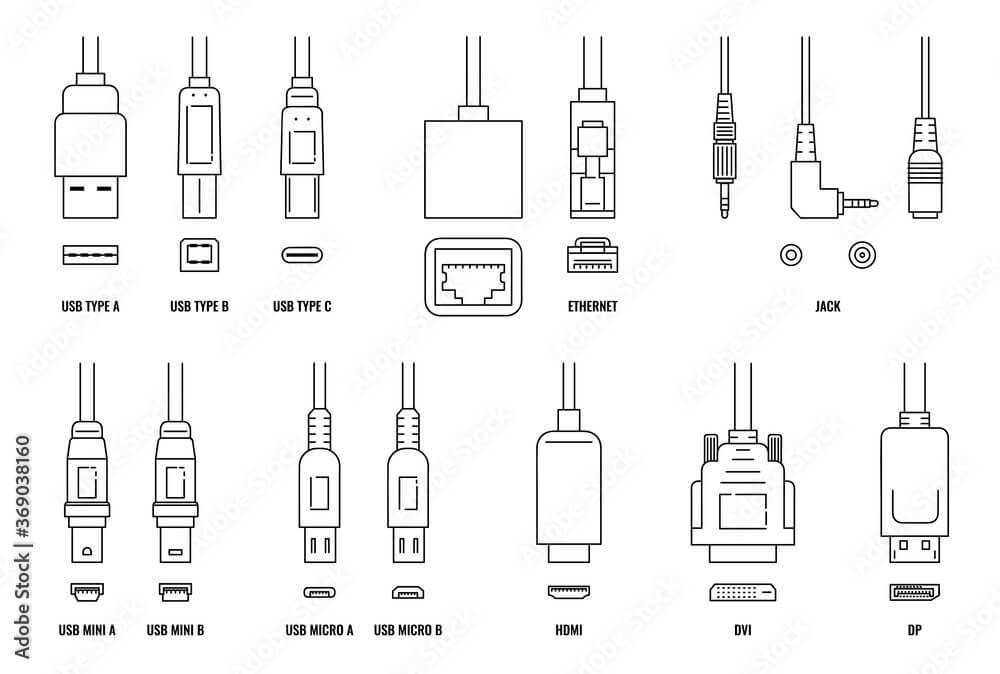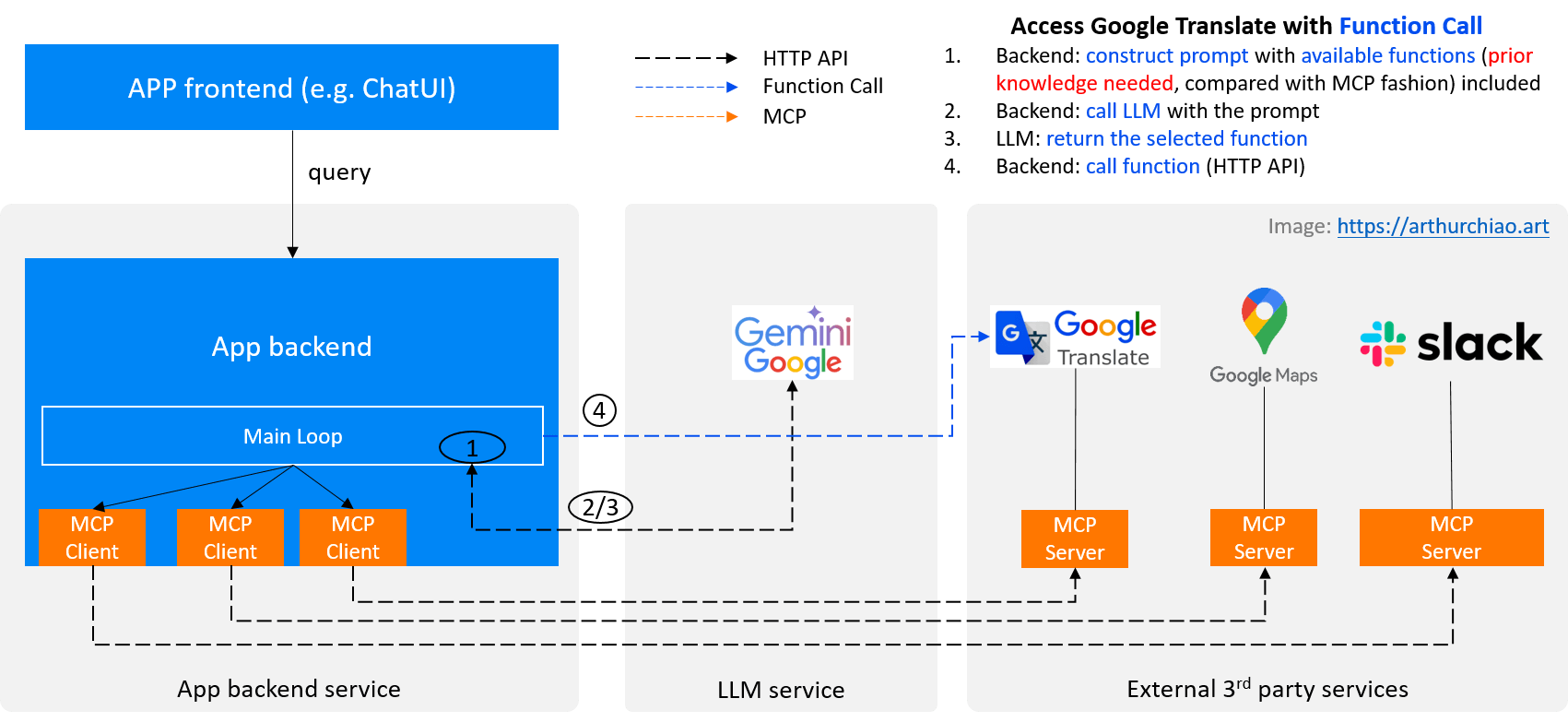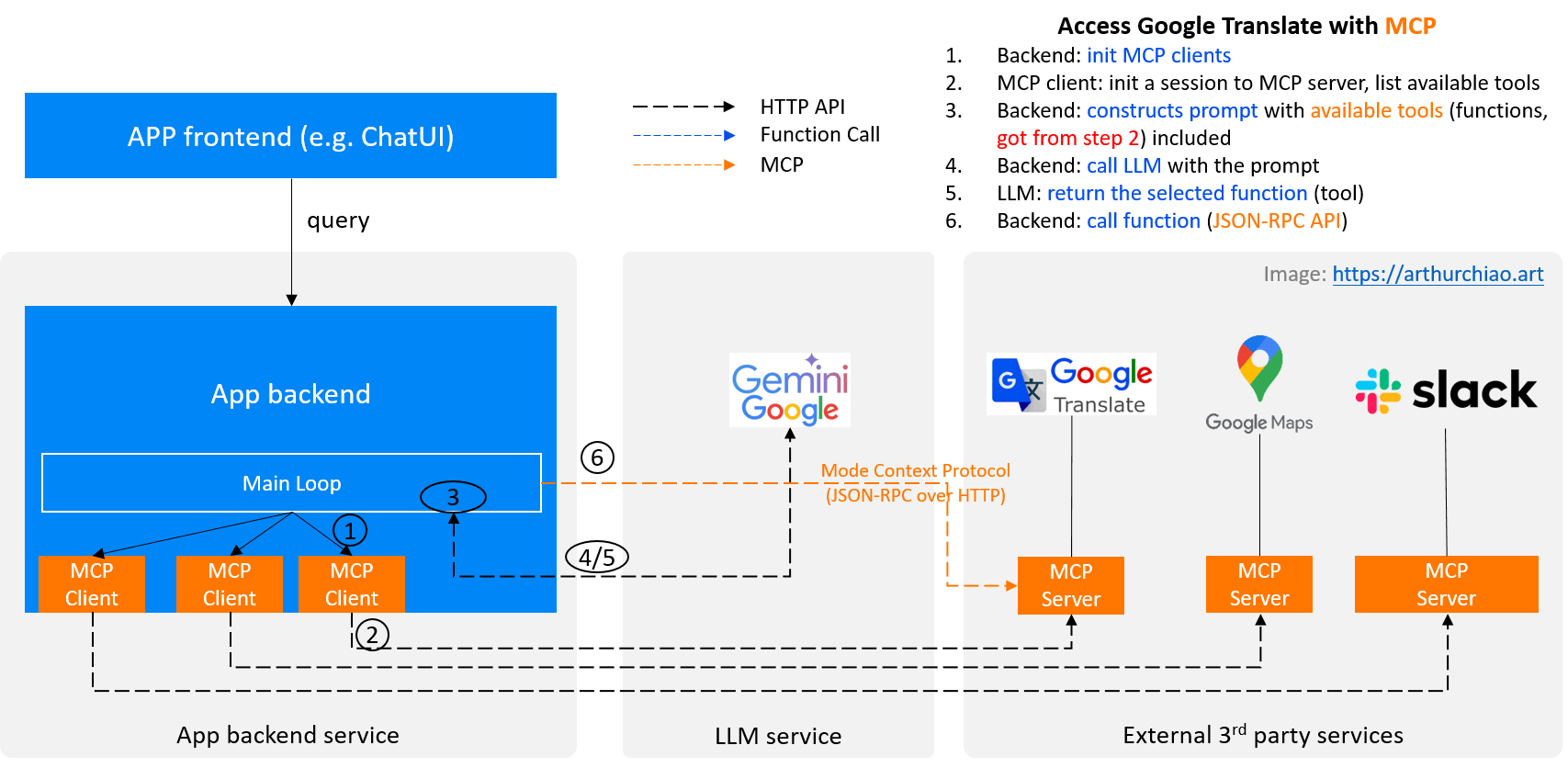But What Is MCP (Model Context Protocol)? (2025)
There are already some good documents for MCP,
- Model Context Protocol documentation
- Model Context Protocol specification
- Officially supported servers
but developers and architects may still feel confusing on how it works in the underlying, and this post try to fill the gap.

Fig. Integrate external services to AI applications with MCP. Note that MCP also supports connecting to local services (co-located with the AI application) with the same client-server architecture.
1 What’s MCP?
1.1 Naming
MCP is an abbreviation for Model Context Protocol. From the name, we can see that
- First of all, it’s a communication protocol,
- Then, it’s for models (LLMs),
- At last, it is used for exchanging/passing model context.
1.2 Why MCP?
When building agents or complex workflows on top of LLMs, it is often necessary to integrate with external data or tools (e.g. external MySQL, Google Maps). MCP provides a standardized way to do this.
Let’s use an analogy to better explain it.
1.3 Analogy
Traditionally, personal computers have a variety of hardware connectors, such as USB, HDMI, DP, RJ45, etc.

Various kinds of hardware connectors.Image Source
Computer designers have to decide what devices that they would like to support during
the design phase, and then pre-install the corresponding hardware interfaces on the motherboard.
When new kinds of hardware connectors come in, it’s impossible to support them
without changing the motherboard, or introducing new kinds of hardware
adapters.
1.3.1 USB type-c for computer
With the introduction of USB type-c specification, things have changed. USB type-c is becoming the standard connector for most devices. As illustrated below,

Fig. Peripheral devices connected to a computer's USB type-c hub with adapters.
When the computer needs to connect to many peripherals, it first plugs in a USB
type-c hub (the actual hub generally supports multiple interfaces, not just
type-c), and for those peripheral devices,
- If they are already of type-c, they can connect to the hub directly;
- Otherwise, such as they are some old devices or professional devices in specific fields, they can be converted to type-c through a adapter first, then connecting to the hub.
So, as long as a device supports (directly or through a converter) the type-c interface, it can be easily integrated to the computer.
1.3.2 MCP for AI Apps
MCP is like a USB-C port for AI applications. Just as USB-C provides a standardized way to connect your devices to various peripherals and accessories, MCP provides a standardized way to connect AI models to different data sources and tools.
An analogy is shown below,

Fig. Integrate external services to AI applications with MCP. Note that MCP also supports connecting to local services (co-located with the AI application) with the same client-server architecture.
From the left to right,
Personal Computer case |
AI App case |
Notes |
|---|---|---|
| Peripherals, such as monitors | External data or services, such as Google Translate |
To be integrated into the AI application. They may use various protocols, such as HTTP, WebSocket, gRPC, Redis protocol, etc. |
| Connector adapters | Protocol adaptation layer (server-side) |
One MCP server for each external service, providing a standardized interface (JSON-RPC) to the MCP client. |
| USB type-c hub | Protocol adaptation layer (client-side) |
One MCP client for each external service, connecting the corresponding MCP server with standard protocol. |
| The personal computer | The AI app | The main part, integrate external services with the MCP clients. |
| LLM layer | AI apps rely on LLM services for function calling to the external services with MCP. |
1.4 Summary
MCP is an open protocol that standardizes how applications provide context to LLMs. Think of MCP like a USB-C port for AI applications. Just as USB-C provides a standardized way to connect your devices to various peripherals and accessories, MCP provides a standardized way to connect AI models to different data sources and tools.
2 Architecture & Spec
MCP follows the classic client-server architecture.
2.1 Base Protocol
- JSON-RPC message format
- Stateful connections
- Server and client capability negotiation
2.2 Server side
MCP Primitives
The MCP protocol defines three core primitives that servers can implement:
| Primitive | Control | Description | Example Use |
|---|---|---|---|
| Prompts | User-controlled | Interactive templates invoked by user choice | Slash commands, menu options |
| Resources | Application-controlled | Contextual data managed by the client application | File contents, API responses |
| Tools | Model-controlled | Functions exposed to the LLM to take actions | API calls, data updates |
Server Capabilities
MCP servers declare capabilities during initialization:
| Capability | Feature Flag | Description |
|---|---|---|
prompts |
listChanged |
Prompt template management |
resources |
subscribe listChanged |
Resource exposure and updates |
tools |
listChanged |
Tool discovery and execution |
logging |
- | Server logging configuration |
completion |
- | Argument completion suggestions |
2.3 Client side
Clients may offer the following feature to servers:
- Sampling: Server-initiated agentic behaviors and recursive LLM interactions
MCP client gets the server’s capabilities through APIs such as list_tools.
Note that LLM is only responsible for selecting functions, the actual function calling is triggered inside the AI app.
2.4 Programming examples
- https://modelcontextprotocol.io/quickstart/client
- https://github.com/modelcontextprotocol/python-sdk
3 Function Call vs. MCP
Conceptually, MCP and Function call are both for AI applications to easily call external services, but their work in different ways. Let’s take a look at the workflow of a specific example —— accessing the Google Translate API —— and see the difference between these two methods.
3.1 Function Call

Fig. Function call workflow for accessing Google Translate.
Steps:
- AI app:
build prompt, include thefunction informationof the Google Translate API in the prompt; - AI app:
call LLM with the prompt; - LLM: model response, with the
selected functionincluded; - AI app:
calling into the Google Translate APIwith (HTTP/HTTPS);
3.2 MCP
The same scenario for MCP:

Fig. MCP workflow for accessing Google Translate.
Steps:
- AI app:
init MCP client with the MCP server addressof Google Translate service; - MCP client: get the capabilities of Google Translate MCP server via MCP server’s built-in
list_toolsAPI; - AI app:
build prompt, include all thefunction informationof the Google Translate API (got from step 2) in the prompt; - AI app:
call LLM with the prompt; - LLM: model response, with the
selected functionincluded; - AI app:
calling into the proper Google Translate APIwith MCP.
3.3 Comparison
| Function Call | MCP | |
|---|---|---|
| Prior knowledge of the AI app (configurations) | Exact function names and parameters | MCP server addresses |
| Functions the AI apps can use | Static, only the pre-configured functions | Dynamic, all functions the MCP server exposed via list_tools interface |
| Flexibility | Low | High |
| Token consumption | Low | High. When building a prompt, too many functions’ descriptions may be included into the prompt |
4 Limitations of current MCP
4.1 Cursor
https://docs.cursor.com/context/model-context-protocol#limitations
MCP is a very new protocol and is still in active development. There are some known caveats to be aware of:
Tool Quantity
Some MCP servers, or user’s with many MCP servers active, may have many tools available for Cursor to use. Currently, Cursor will only send the first 40 tools to the Agent.
Remote Development
Cursor directly communicates with MCP servers from your local machine, either directly through stdio or via the network using sse. Therefore, MCP servers may not work properly when accessing Cursor over SSH or other development environments. We are hoping to improve this in future releases.
MCP Resources
MCP servers offer two main capabilities: tools and resources. Tools are availabe in Cursor today, and allow Cursor to execute the tools offered by an MCP server, and use the output in it’s further steps. However, resources are not yet supported in Cursor. We are hoping to add resource support in future releases.
问题总结
1. MCP 客户端问题/对接不同大模型的工作量
官方的 MCP 客户端是绑定 Anthropic 的大模型的(Claude),这意味着使用 OpenAI、 Google Gemini 等其他模型的用户需要自己实现 MCP 客户端,目前还没有看到 OpenAI 官方的 MCP 客户端。
- function 的描述格式
- API 的请求格式、参数格式、返回格式
https://github.com/anthropics/anthropic-sdk-python/issues/384
官方没明确支持 OpenAI compatible API 的计划,另外,相同的 prompt 在不同模型上的表现会有差异,这也是他们不想支持的一个原因。
1. function 数量的问题
不管是 function call 还是 MCP,最后都需要将 function 列表作为 tools 传给 LLM,这个列表可能会很长,如何处理这个问题?
首先,太长可能会超过模型的上下文;
其次,即使没超过上下文长度,也会导致 token 的消耗过多。或者存在一些隐形限制,跟应用有关,例如
- OpenAI 的最佳实践里建议不要超过 20 个 functions;https://platform.openai.com/docs/guides/function-calling/function-calling#best-practices-for-defining-functions
- cursor 里只会发送前 40 个 tools 给 agent。
3. 强依赖提示词 + 大模型的 planning 能力
不同的大模型,planning 能力不同。 在判断使用哪个 function 时,判断能力也不同。
模型依赖:仍然以 anthropic claude 大模型为主
MCP 官方的 SDK https://github.com/modelcontextprotocol/python-sdk/ 是只针对 claude API 设计开发的,这意味着如果用户使用的是 OpenAI、Google 等大模型时,无法直接基于 MCP SDK 快速创建 client/server。
社区有人提了 issue,希望能支持 OpenAI compatible API,但官方表示暂无支持计划 https://github.com/anthropics/anthropic-sdk-python/issues/384 。
目前有一些个人开发的针对 OpenAI compatible API 的类似 MCP SDK 项目,但还没有 star 特别多的,能否持续投入时间迭代待观察。
- https://github.com/bartolli/mcp-llm-bridge
- https://github.com/S1M0N38/mcp-openai
- https://github.com/chrishayuk/mcp-cli
更新:llamaindex 之类的框架,已经封装好了 mcp client 的能力,能避免这个问题。 https://docs.llamaindex.ai/en/stable/api_reference/tools/mcp/

